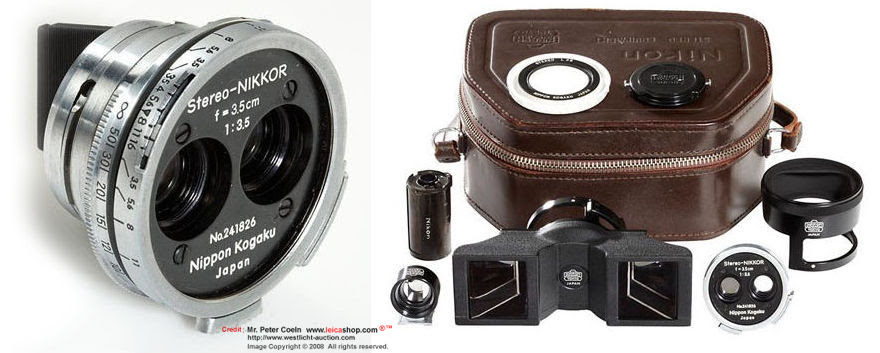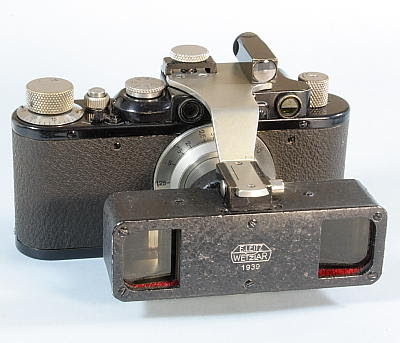By Heinz Richter
It is common knowledge that the modern 35mm system camera was developed in Germany by Leitz (Leica), soon followed by Zeiss with the Contax. The influence of these two camera systems was far reaching and influenced many other camera manufacturers to develop similar cameras.
One such company was Nikon in Japan. During the 1930s, the basis was laid for an independent photographic industry to meet civil and, more importantly, military needs that would become of primary importance following Pearl Harbor and Japan’s entrance into the second world war.
After the war, many of the Japanese camera manufacturers were eager to reenter the domestic and foreign markets. Among all of the Japanese brands, the one that would soon become a household name in the US and Europe was Nikon.
But like so many other manufacturers, they began by closely copying successful German manufacturers, primarily Leitz and Zeiss. Initially, Nikon manufactured only lenses, many of which were copies of lenses made by Leitz as well as Zeiss.
Nikkor QC 50mm f/3.5 Leitz 50mm Elmar f/3.5


W-Nikkor C 35mm f/3.5 Leitz Summaron 35mm f/3.5


W-Nikkor C 35mm f.3.5 Leitz Elmar 35mm f/3.5
The first Nikon camera with interchangeable lenses appeared on the domestic market in March of 1948. Unlike many other manufacturers who simply copied Leica cameras, Nikon, on the other hand, chose to copy the Zeiss Contax. But there was more to the camera than what met the eye. The camera body was clearly a copy of the Zeiss Contax, including the rangefinder and the lens mount. But the shutter was definitely not a Zeiss design. Upon closer inspection it was obvious that it was taken entirely from the Leica. That decision apparently had been made because it was of a much less complicated design (thanks Oskar Barnack) and thus much more reliable than the vertically traveling, roller desk type shutter of the Contax. The Leica shutter was copied in virtually all details resulting in the Nikon being one of the very few cameras that utilized a collar type cable release.

Leica III

Nikon 1
Please note the position of the shutter speed dial, the shutter release, the film winding knob
and the film rewind lever.
Several years later, when it became apparent that rangefinder cameras would be replaced by single lens reflex (SLR) cameras, Nikon simply converted the Nikon rangefinder camera to an SLR by eliminating the rangefinder from the camera and adding a mirror housing. Thus the original Nikon F was born. It too featured the Leica shutter, virtually unchanged. The Nikon F soon became one of the most successful, professional SLRs on the market and Leica technology was a definite part of that.


Leica III Nikon F SLR
Using the Leica shutter offered another, little known feature, mostly unknown to even Leica users. The Leica shutter used by Nikon was that of the Leica screw mount cameras and it made those Leicas, the Nikon rangefinder and Nikon F SLRs the only cameras to ever incorporate that feature.
It was the ability to allow double exposure with perfect registration, but not just simple double exposures on the last frame but with any frame that had been exposed on the roll of film.
Users of these cameras might have noticed that the shutter release button turns when rewinding the film. To make a double exposure on the last exposed frame all that is necessary is to activate the rewind release and winding the film back for one full revolution of the shutter release button and then go beyond that for not quite another half revolution. After that the camera has to be switched back to the film advance mode and the film transport knob or advance lever moved to cock the shutter. This will also advance the film which will automatically stop with perfect registration on the last exposed frame. At this point the second exposure can be taken on that frame. Repeating the above steps will allow unlimited exposures on the same frame.
To take additional exposures on any previous frame one needs to do the same procedure as above. Except rather than winding the film back just one revolution of the shutter release knob, one needs to make it do as many revolutions as the number of frames the one is back that is to receive the additional exposure. Don’t forget to go about one half revolution beyond, activate the advance until it stops and take the exposure.
To go back to taking a new picture, block any light from entering the lens and take as many ‘blind’ exposures as the number of frames you wound back.
This might require some practice. To do that with any accuracy, take an old, unexposed or undeveloped roll of film and load it into the camera. With the camera set on ‘B’ and with the lens removed, take several frames and mark the outline with a pen and number the frames consecutively. This will allow you to practice the above procedure with any number of frames.
A fact only known to few is the fact that Nikon also considered to use the Leica screw mount on their early cameras instead of the Contax mount. However, this did not proceed beyond the prototype stages and all of the Nikon rangefinder camera that reached the market did feature the Contax mount.

Leica Screw Mount Prototype #1
Very closely based on the Contax, but definitely shows the use
of the Leica shutter

Leica Screw Mount Prototype #2
Very closely based on the Contax, including the self timer lever,
featuring the Leica shutter

Leica Screw Mount Prototype #3
Close to the later Nikon rangefinder lay-out, Leica shutter

Leica Screw Mount Prototype #4
Very close to the marketed Nikon rangefinder with Leica shutter
A 5th prototype with Leica screw mount was recently sold by Wetzlar Camera Auctions (WCA)
Just like the other prototypes, this too clearly made use of the Leica shutter
Besides copying lenses and cameras, Nikon’s line of accessories also consisted of quite a variety of copies of Leica accessories.
Rangefinder cameras by their very nature are limited in their ability to do close up photography as well as photography with lenses longer than 135mm. To overcome that problem, Leica developed a single lens reflex viewing attachment. When added to the camera, it allowed viewing through the lens, allowing to focus accurately when doing close ups as well as when using long lenses. The first in the line of the reflex viewing attachments was the PLOOT. Later versions became known as the Visoflex. Nikon too offered such an attachment and the similarity to the Leica version is undeniable.

Nikon reflex focusing unit

Leitz PLOOT
After the first Leica appeared on the market in 1925, models with interchangeable lenses were soon to follow. Since the viewfinder of those cameras only showed the field of view of the 50 mm lens, accessory viewfinders for the other focal length lenses became a necessity. This resulted in the Vidom, a universal viewfinder that could be adjusted to show the field of view of focal lengths from 35 mm to 135 mm. Nikon, faced with the same problem, simply copied the design of the Vidom rather than developing a viewfinder of their own design.


Nikkor Multi Focal Finder Leitz Vidom
Stereo photography was quite popular for a while and Leitz made a variety of accessories that allowed to take stereo photographs and again, Nikon simply copied these designs for their own use.
The Nikon Stereo-Nikkor 35mm f/3.5 outfit consisted of a stereo lens and stereo prism for the Nikon rangefinder cameras. Introduced in 1956, it bears more than a close resemblance to the Leitz Stereoly, first introduced in 1931 and later replaced by an improved model in 1954.

Nikon Stereo Nikkor 35mm f/3.5

Patent drawing of Leitz Stereoly attachment

Leitz Stereoly on early Leica II

Leitz Stemar 35mm f/3.5
In either case, this stereo equipment produced two half frame stereo images in place of the standard 35mm frame. Stereo viewers and projector accessories allowed for stereo viewing of the images taken.
Thus we have another example of the influence Leica has had on Nikon over the years. This isn't to say that NIkon could not have been successful without Leica, but copying Leica cameras, lenses and accessories definitely eliminated a lot of development time for them. Considering how many other manufacturers copied Leica, Leica cameras, lenses and accessories remain the most copied photographic equipment in history.
For other articles on this blog please click on Blog Archive in the column to the right
To comment or to read comments please scroll past the ads below.
All ads present items of interest to Leica owners.
_______________________________________________________________________
To comment or to read comments please scroll past the ads below.
All ads present items of interest to Leica owners.
_______________________________________________________________________
Buy vintage Leica cameras from America's premier Leica specialist
Buy vintage Leica cameras from
America's premier Leica specialist
Click on image to enlarOrder: info@gmpphoto.comPlease make payment via PayPal to GMP Photography
Click on image to enlargeOrder: info@gmpphoto.com
Click on image to enlar
Order: info@gmpphoto.com
Please make payment via PayPal to GMP Photography
Click on image to enlarge
Order: info@gmpphoto.com
Please make payment via PayPal to GMP Photography
Click on image to enlarge
Order: info@gmpphoto.com
Please make payment via PayPal to GMP Photography
















The Nikon rangefinder cameras were not Leica copies.
ReplyDeleteI never said they were. What I did say is that Nikon decided to copy the Leica shutter from the Leica SM cameras for use in the Nikon rangefinder cameras. The camera bodies, the lens mount and the rangefinder were copies of the Zeiss Contax camera. The connection to Leica is further shown by the fact that Nikon also considered to copy the Leica screw mount as shown by 5 prototype cameras.
DeleteDidn't Nikon copy some Zeiss lenses as well?
DeleteYes they did
Delete